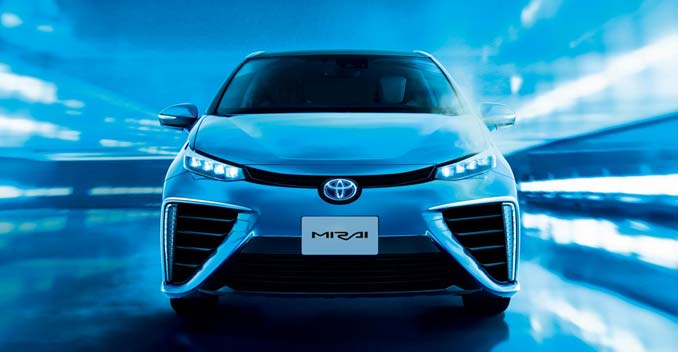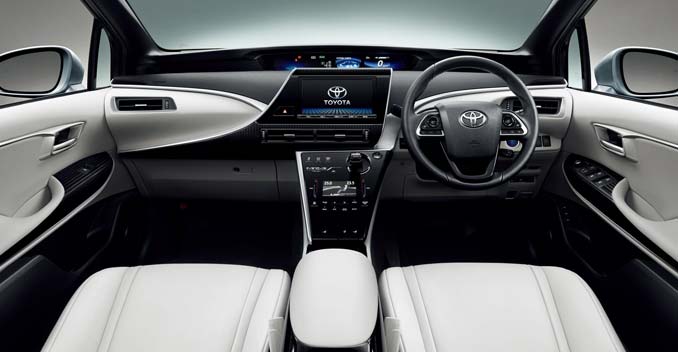Toyota Mirai Review

Highlights
Mirai stands for 'future' in Japanese, and it truly becomes Toyota's claim that 'the future is here'. The Mirai is the Japanese carmaker's first mass-production hydrogen-power fuel-cell car and it comes after 20 years and millions of dollars worth of investment in research and development. So the question remains, could this be the next Prius?
The Mirai sports a pretty interesting and futuristic design; some of it is a little awkward and weird to look at, but the idea was to project 'maximum air intake' with the car's design. That said, the big grills/air ducts on either side of the front bumper are the most striking feature of its design. The idea is that to streamline air as much as possible while you drive, and this is clearly one of the most striking elements that you find in the car.

However, the Mirai's design isnt for everyone, especially with it's slightly awkward proportions. But the interior will give you something to smile about; it looks more futuristic than the Prius with a couple of black touchscreen panels below the curved dashboard. On the top center of the dash, there is the speedometer, gear indicator and driving details of the powertrain. Below it is the navigation and infotainment screen carried forward from the Prius. The quality of the cabin materials is impressive and so are the 8-way adjustable seats. Decent head-room up front, but it takes a hit in the rear, thanks to the placement of the hydrogen tanks below the floor. Boot space is sufficient at 371-litres.
Since hydrogen is quite a complicated technology to generate power out of, here's a quick download of how the system exactly works. The gas goes through a hydrogen fuel cell stack that mixes oxygen with the hydrogen and this reaction, in turn, generates electricity to charge the on-board battery. The car is powered by a 114 kilowatt fuel cell stack along with a 113 kilowatt electric motor on board. The combination of hydrogen and oxygen creates pure water, which is dumped via the tailpipe while driving or when the vehicle is parked.

Toyota claims that under the Japanese test cycle, Mirai offers a range of 650Kms with the two hydrogen tanks. However, the real world driving distance could be about 550Kms. And here's the other big surprise, unlike electric vehicles, which take time to charge, refilling the tank of the Mirai with hydrogen will take less than 5 minutes.
Currently Japan has only 10 hydrogen stations, though there's a plan to take that number up to 100 by the end of 2015. Also, Toyota has looked to address concerns of Mirai's safety by ensuring the hydrogen and the tanks are safe and can handle high-speed crashes. The Mirai is also equipped with sensors to provide warnings and shut off the tanks' main stop valves in case of a leak.
The short drive on a small track offered a basic idea of the Mirai's driving dynamics. The engine feels fairly powerful and also comes along with the option of a 'power mode' that releases more hydrogen into the fuel cells which gets into the electric motor. Long story short, it lets you have some fun with the Mirai.
The car is a bit like the Prius to drive, though it remains completely silent unlike the Prius, thanks to a missing petrol engine. The car does promise a punch with its 335Nm of torque and over 150 horses.
Anyway, back to why the drive is very similar to the Prius; it is because the Mirai borrows quite a bit from the Prius's electric powertrain in a bid to keep the costs down. But this is a heavier car and weighs about 1850Kgs, and you feel the weight when you push the car around corners. The steering and the braking managed to impress us in whatever little time we got to drive the Mirai. On the flat stretch we drove, the suspension did feel a bit stiff that endows it with better handling feel than the Prius.

Toyota has officially launched the Mirai in Japan, and it will land in the US and select European markets by the second half of 2015. Priced at around $57,500 or approximately Rs. 35 lakh, the Mirai's price could dip a little with select markets offering government incentives. Challenges like lack of hydrogen stations will be the biggest hurdle, so Toyota is ensuring that the Mirai is launched in a phased manner. But for now we are happy to show you this slice of the future.
Last Updated on September 11, 2015
Related Articles
Latest Reviews
Popular Toyota Models
 Toyota FortunerEx-Showroom Price₹ 33.43 - 51.44 Lakh
Toyota FortunerEx-Showroom Price₹ 33.43 - 51.44 Lakh Toyota Innova CrystaEx-Showroom Price₹ 19.13 - 26.3 Lakh
Toyota Innova CrystaEx-Showroom Price₹ 19.13 - 26.3 Lakh Toyota RumionEx-Showroom Price₹ 10.44 - 13.73 Lakh
Toyota RumionEx-Showroom Price₹ 10.44 - 13.73 Lakh Toyota Urban Cruiser TaisorEx-Showroom Price₹ 7.74 - 13.04 Lakh
Toyota Urban Cruiser TaisorEx-Showroom Price₹ 7.74 - 13.04 Lakh Toyota Land CruiserEx-Showroom Price₹ 2.31 - 2.41 Crore
Toyota Land CruiserEx-Showroom Price₹ 2.31 - 2.41 Crore Toyota Urban Cruiser HyryderEx-Showroom Price₹ 11.14 - 20.19 Lakh
Toyota Urban Cruiser HyryderEx-Showroom Price₹ 11.14 - 20.19 Lakh Toyota Innova HycrossEx-Showroom Price₹ 19.09 - 31.34 Lakh
Toyota Innova HycrossEx-Showroom Price₹ 19.09 - 31.34 Lakh Toyota CamryEx-Showroom Price₹ 48 Lakh
Toyota CamryEx-Showroom Price₹ 48 Lakh Toyota GlanzaEx-Showroom Price₹ 6.81 - 10 Lakh
Toyota GlanzaEx-Showroom Price₹ 6.81 - 10 Lakh Toyota VellfireEx-Showroom Price₹ 1.22 - 1.33 Crore
Toyota VellfireEx-Showroom Price₹ 1.22 - 1.33 Crore Toyota Fortuner LegenderEx-Showroom Price₹ 43.66 - 47.64 Lakh
Toyota Fortuner LegenderEx-Showroom Price₹ 43.66 - 47.64 Lakh Toyota HiluxEx-Showroom Price₹ 30.4 - 37.9 Lakh
Toyota HiluxEx-Showroom Price₹ 30.4 - 37.9 Lakh
- Home
- Reviews
- Auto Industry
- Toyota Mirai Review














